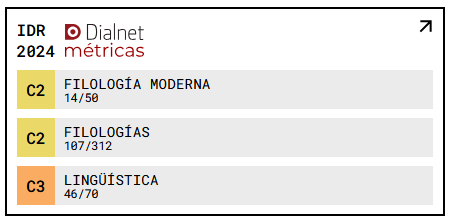The Semantics and Syntax of Old English Motion Verbs
DOI:
https://doi.org/10.18172/jes.5808Keywords:
Old English., Motion verbs, Semantics, Syntax, Verbal classes, Morphosyntactic alternationsAbstract
This is a study in the syntax and semantics of Old English verbs of motion, including verbs of neutral motion, verbs of manner of motion and verbs of path of motion. Its aim is to identify the morphosyntactic alternations in which these verbs participate. The theoretical basis of the research draws on Goddard’s semantics of motion, Levin’s model of verb classes and alternations and Talmy’s typological distinction between satellite-framed languages and verb-framed languages. The grammatical patterns of the verbs under analysis are discussed, as described in The Dictionary of Old English (Healey), with special emphasis on the study of transitivity, case, prepositional government, and reflexivity. As far as meaning components are concerned, this work concentrates on the study of polysemy. The conclusions of this study refer to the consistency of the syntactic behaviour of the verbs under analysis and the main alternations found within the verbal classes.
Downloads
References
Bosworth, Joseph, and Northcote Toller. An Anglo-Saxon Dictionary. Clarendon Press, 1972 (1898).
Brook, George L. An introduction to Old English. Manchester UP, 1966 (1955).
Campbell, Alistair. Old English Grammar. Oxford UP, 1987 (1959).
Clark Hall, John R. A Concise Anglo-Saxon Dictionary. University of Toronto Press, 1996 (1896).
Faber, Pamela, and Ricardo Mairal. Constructing a Lexicon of English Verbs. Mouton, 1999. DOI: https://doi.org/10.1515/9783110800623
Fanego, Teresa. “Motion events in English: the emergence and diachrony of manner salience from Old English to Late Modern English.” Folia Linguistica Historica, vol. 33, 2012, pp. 29-85. https://doi.org/10.1515/flih.2012.003 DOI: https://doi.org/10.1515/flih.2012.003
Goddard, Cliff. “The semantics of coming and going.” Pragmatics, vol. 7, no. 2, 1997, pp. 147-162. https://doi.org/10.1075/prag.7.2.02god DOI: https://doi.org/10.1075/prag.7.2.02god
Healey, Antonette diPaolo et al., editors. The Dictionary of Old English Web Corpus. Dictionary of Old English Project, Centre for Medieval Studies, University of Toronto, 2004.
Healey, Antonette diPaolo, editor. The Dictionary of Old English in Electronic Form A-H. Dictionary of Old English Project, Centre for Medieval Studies, University of Toronto, 2016.
Hogg, Richard. “Phonology and morphology.” The Cambridge History of the English Language Vol. 1.: The Beginnings to 1066, edited by Richard Hogg, Cambridge UP, 1992, pp. 67-167. DOI: https://doi.org/10.1017/CHOL9780521264747.004
Hogg, Richard, and Robert Fulk. A Grammar of Old English. Vol. 2.: Morphology. Blackwell, 2011. DOI: https://doi.org/10.1002/9781444327472
Huber, Judith. “Motion and the English verb: a diachronic study.” Poster presented at SYLEX III Conference, University of Zaragoza, 2013.
Levin, Beth. English Verb Classes and Alternations. University of Chicago Press, 1993.
Martín Arista, Javier. “Sintaxis medieval I: complementación, caso y sintaxis verbal”. Lingüística histórica inglesa, edited by Isabel de la Cruz Cabanillas and Javier Martín Arista, Ariel, 2001, pp. 224-312.
Martín Arista, Javier. “Why Old English does not have syntactic causative active accomplishments of motion.” Paper presented at 2016 Conference of the Societas Linguistica Europeæ, University of Naples, 2016.
Martín Arista, Javier, and Raquel Mateo Mendaza. “Nerthus. Outline of a lexicon of Old English.” Working Papers in Early English Lexicology and Lexicography, no. 3, 2013, pp. 1-1992.
Martín Arista, Javier et al., editor. NerthusV3. Online Lexical Database of Old English. Nerthus Project, Universidad de La Rioja, 2016, www.nerthusproject.com.
Mitchell, Bruce, and Fred C. Robinson. A Guide to Old English. Blackwell, 1995 (1964).
Ogura, Michiko. Verbs with the Reflexive Pronoun and Constructions with Self in Old and Early Middle English. Brewer, 1989.
Ogura, Michiko. Verbs of Motion in Medieval English. Brewer, 2002. DOI: https://doi.org/10.1515/9781846151651
Pintzuk, Susan, and Lennart Plug, editors. The York-Helsinki Parsed Corpus of Old English Poetry. Department of Language and Linguistic Science, University of York, 2001.
Pyles, Thomas, and John Algeo. The Origins and Development of the English Language. Harcourt Brace Jovanovich, 1982 (1964).
Ringe, Donald, and Ann Taylor. A Linguistic History of English. Vol. 2. The Development of Old English. Oxford UP, 2014. DOI: https://doi.org/10.1093/acprof:oso/9780199207848.001.0001
Robinson, Orrin. Old English and its Closest Relatives. A Survey of the Earliest Germanic Languages. Routledge, 1992.
Smith, Jeremy. Old English. A Linguistic Introduction. Cambridge UP, 2009. DOI: https://doi.org/10.1017/CBO9780511812330
Sweet, Henry. The Student’s Dictionary of Anglo-Saxon. Cambridge UP, 1976 (1896).
Talmy, Leonard. “Lexicalization patterns: semantic structure in lexical forms.” Language Typology and Syntactic Description. Vol. 3.: Syntactic Categories and the Lexicon, edited by Timothy Shopen, Cambridge UP, 1985, pp. 57-149.
Talmy, Leonard. Toward a Cognitive Semantics. The MIT Press, 2001. DOI: https://doi.org/10.7551/mitpress/6847.001.0001
Taylor, Ann, et al., editors. The York-Toronto-Helsinki Parsed Corpus of Old English Prose. Department of Language and Linguistic Science, University of York, 2003.
Van Valin, Robert, and Randy LaPolla. Syntax. Structure, Meaning and Function. Cambridge UP, 1997. DOI: https://doi.org/10.1017/CBO9781139166799
Weman, Bertil. Old English Semantic Analysis and Theory. With Special Reference to Verbs Denoting Locomotion. Kraus Reprint Limited, 1967.
Downloads
Published
How to Cite
Issue
Section
License
Copyright (c) 2024 Sara Domínguez Barragán

This work is licensed under a Creative Commons Attribution 4.0 International License.
The authors retain copyright of articles and authorize Journal of English Studies the first publication. They are free to share, redistribute, and/or reprint the article without obtaining permission from the publisher as long as they give appropriate credit to the editor and the journal.
Self-archiving is allowed too. In fact, it is recommendable to deposit a PDF version of the paper in academic and/or institutional repositories.
It is recommended to include the DOI number.
This journal is licensed under a Creative Commons Attribution 4.0 International License













